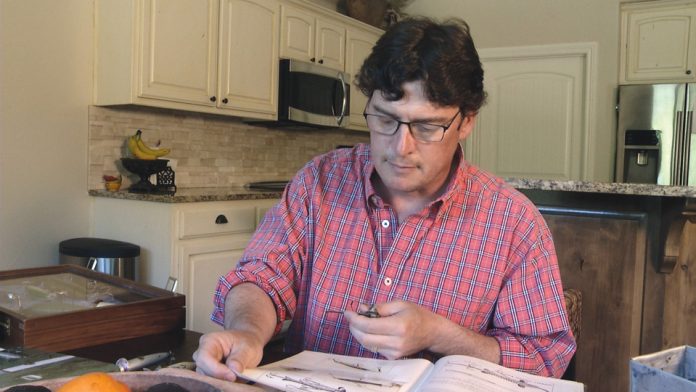
Ardmore man hopes procedure will save his eye and his life
At first it was hardly noticeable, then a nuisance and then something much more for Matthew Lollman of Ardmore. Lollman, 44, has melanoma. It’s not on his skin, though, as one might suspect. It’s in his eye.
“I actually had known that I had a blind spot and didn’t tell anybody for the longest time,” he said.
Then at a gathering of friends, he joked about needing to buy a larger phone instead of just admitting to being over 40 and needing to have his eyes checked. That’s when a friend, who is also an optometrist, offered to take a look at his eyes for free.
“Within 20 minutes, she noticed that it wasn’t just a normal vision problem. Every time she flipped a different lens over my eye, it still had the same result. It was as if someone put their finger and smudged over the camera lens,” Lollman said.
When she dilated his eyes, she noticed something more. There was a dark spot, almost like a freckle, in the back of his eye. She immediately recommended that he see a specialist at Dean McGee Eye Institute in Oklahoma City for further evaluation.
There Dr. Brian Firestone, an ophthalmologist who specialized in cancers of the eye among other things, ran some tests and made the diagnosis. It was melanoma and it was in the part of his eye known as the uvea, the middle layer of the eye wall.
“Uveal melanoma makes up only 3 percent of all cases of melanoma and occurs in just 6 out of a million people each year. So it’s not real common, but we do see it,” Firestone said. “The challenge is that uveal melanoma is a cancer that has the potential to spread from the eye to other parts of the body. So it really is best to treat it promptly.”
Firestone said there are three main goals in treatment: 1) Save the patient’s life 2) Salvage the eye when possible 3) Retain as much useful vision as possible
Lollman and his wife quickly began to research his condition and what they learned was sobering.
“While other tumors tend to grow and then spread, ocular melanoma is different in that it spreads from the beginning. The moment it became a tumor, it spreads through your blood system,” Lollman said.
Being very aware of the risk the cancer posed to his life, Lollman weighed his options. He considered having his eye removed. However, Firestone offered another option that would allow him to keep his eye – radioactive plaque therapy.
“This treatment utilizes a small disc containing radioactive seeds surgically placed onto the eye over the tumor. Each plaque is custom-designed based on the size, shape and location of the tumor. The plaque remains on the eye for about 4 days and is then surgically removed. So no radiation remains on the eye after the treatment,” Firestone explained.
Lollman and his wife decided it was the best option for him. So a team of experts was assembled, included Dr. Firestone and his colleagues at Dean McGee Eye Institute, Tania De La Fuente Herman, Ph.D., a radiation specialist with Stephenson Cancer Center and the surgical support team at OU Medicine Surgery Center.
De La Fuente Herman carefully calculated the radiation dosage for the seeds that were then incorporated into the plaque. Next, the plaque was surgically implanted in Lollman’s eye in an operating room at the Surgery Center. Dr. Firestone also took a small sample of the tumor so that they could do special DNA testing on it. Four days later, Lollman returned to the OR and the plaque was removed.
“The prognosis going forward is pretty good,” said Lollman with a tone of optimism in his voice.
He hopes to learn in 3 to 6 months that the tumor is shrinking. He knows that his vision in that eye may never be perfect, but he is grateful to his medical team and especially thankful his friend offered him a free eye exam.
“The worst that could have happened is that I could have died on my couch not having known what was going on,” he said.
Firestone said that Lollman’s story, though relatively rare, is actually not unusual.
“Oftentimes, these patients either had no idea there was a problem in their eye or thought they lost vision because of another eye condition. They never expected to be diagnosed with an eye cancer,” Firestone said. “I get to help them through that with compassion and confidence. I get to help patients through a real crisis in their lives and that’s rewarding.”
The public may view a video of Lollman’s story at this link: https://youtu.be/nFAnzFoa9RM












